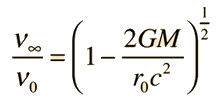Gravity and the Photon
The relativistic energy expression attributes a mass to any energetic particle, and if applied to the photon with its zero rest mass:

The effective gravitational potential energy* is then

If an emitted photon of frequency υ0 moves relative to the gravitational mass, it will have a measurably different frequency

Since it is reduced in frequency, this is called the gravitational red shift or the Einstein red shift. The above expression is an approximation for weak gravity fields, which can be applied to small laboratory displacements on the Earth like the Harvard Tower experiment, but can be generalized for gravitational fields of any strength.
*The idea of "gravitational potential energy" for a photon must be brought into consistency with general relativity, which would attribute the gravity effect to the local curvature of space-time. So any "effective mass" for the photon is subject to the same difficulties as the "relativistic mass" for a high speed particle.
| Escape energy for a photon |
General relativity ideas
| HyperPhysics***** Relativity | R Nave |


